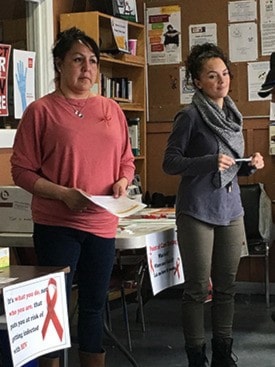Barbara Latkowski
Caledonia Courier
The KEY was open on Dec. 1 but it wasn’t just a normal day.
It was a day designated in support of HIV/AIDS awareness.
December is Aids Awareness Month and Aboriginal Aids Awareness Week runs from Dec. 1 – 5.
Lisa Sam, from Nak’zdli Band was thrilled to host the event at The Key which was open to anyone.
“It dosen’t matter if you a man or woman, straight or gay, native or not, anyone can get HIV,” Sam said. “It touches everybody’s lives.”
Sam also spent the day distributing red ribbons to help raise awareness to various businesses and organizations in Fort St. James.
“We have to keep raising awareness and encourage regular testing to lessen the risk of passing it on to others,” Sam said.
About 20 percent of the population in Canada doesn’t even realize that they are infected. That’s one in five people. With regular testing, treatment will prolong many lives.”
Stephanie Sutton, a nurse at Nak’azdli Health Centre was on hand to answer questions and provide valuable information about the disease.
“There are so many myths out there,” Sutton said. “The key is regular testing and practicing safe sex.”
Sutton stressed the importance of having naloxone kits on hand in case of the possibility of an overdose.
The kit can save lives by helping reverse the overdose.
For Bernice Wilkes, coordinator at The KEY, this is a problem she has seen time and time again in Fort St. James.
“Drugs continue to be a problem. These kits can help save lives,” Wilkes said. “We have to talk about this and educate everyone.”
HIV stands for human immunodeficiency virus.
AIDS stands for acquired immunodeficiency syndrome.
There is no cure for HIV but there is treatment available.
“Pregnant mothers with HIV can be treated to prevent their babies from being born with it,” Sam said. “This is another reason why regular testing is so important.”
If you are HIV-positive and pregnant, you can reduce the chances of your child being HIV-positive to less than 1 percent by getting proper HIV treatment and care and not breast feeding after birth.
Only five body fluids can contain enough HIV to infect someone: blood, semen, rectal fluid, vaginal fluid and breast milk.
HIV can only get passed on when one of these fluids enters the bloodstream of another person through broken skin, opening of the penis or the wet linings of the body, such as the vagina, rectum or foreskin.
HIV cannot pass through healthy, unbroken skin.
The two main ways that HIV is passed today is though sex and sharing needles.
It cannot be passed by: talking, shaking hands, kissing, hugging, coughing, sneezing, swimming pools, toilet seats, bed sheets, insects or animals.
There are things you can do to practice safer sex. This includes: using a latex condom, use only water-based or silicone-based lubricants, if you are already HIV-positive, talk to your doctor about treatment, Get tested regularly, avoid sharing sex toys, use a condom or dental dam during oral sex and choose forms of sexual stimulation that pose little or no chance of HIV.
To practice safer drug use: use a clean and new needle, use your own drug equipment and get tested regularly.
Since November 1985, all blood products in Canada are checked for HIV. A person’s risk of being infected from a blood transfusion is very, very low according to CATIE.
“There are resources and places you can turn to in the community,” Sam said.
“You can go the Nak’azdli Health Centre, the clinic, Stuart Lake Hospital and there are various websites that offer a great deal of information.”
“We have to teach and make sure people are aware of the realities of HIV,” Sam said.
For more information about receiving a naloxone kit, contact Stephanie Sutton at: (250) 996-7400.
